A new journey with Awabancha
Awabancha is a tea that is only produced in the town of Kamikatsu of Tokushima Prefecture. It is a rare lacto-fermented tea, and the DIG THE TEA team became fascinated by its flavor and unique charm after visiting Kamikatsu in 2021. We also learned that due to a lack of successors in its production, the future of Awabancha tea was in jeopardy.
In 2022, we decided to join the Awabancha Barrel Owner Program, in which participants experience the process of making the tea from start to finish using traditional methods. We were driven by curiosity and a desire to make tea with our own hands. We also wanted to explore whether we, as a media team, could contribute to the preservation and tradition of Awabancha production.
There are eight main steps in the process of making Awabancha. Steps 1 through 5 are done in the peak of summer which is July through August. Mid-July, the DIG THE TEA Experiments team went to Kamikatsu Town in Tokushima Prefecture, flexed our underused muscles, got drenched in sweat, and experienced this process. The article detailing steps 1 through 5 (up to soaking and fermenting) can be read here.
To complete the remaining steps, we visited Kamikatsu Town again in early September, and proceeded to do steps 6 and 7, which are removing the soaked leaves from the barrel and drying them in the sun. Step 8 of sorting and tasting was done in our office in Tokyo. In this article, we will introduce these remaining steps in detail.
- Harvesting
- Sorting
- Boiling
- Rubbing
- Soaking and fermenting
- Remove from barrel ←We will start here today!
- Drying in the sun
- Sorting and tasting
The best time to sun-dry Awabancha leaves
Awabancha is made in sync with the climate of Kamikatsu Town. In fact, there are very few aspects of the process that humans can actually control.
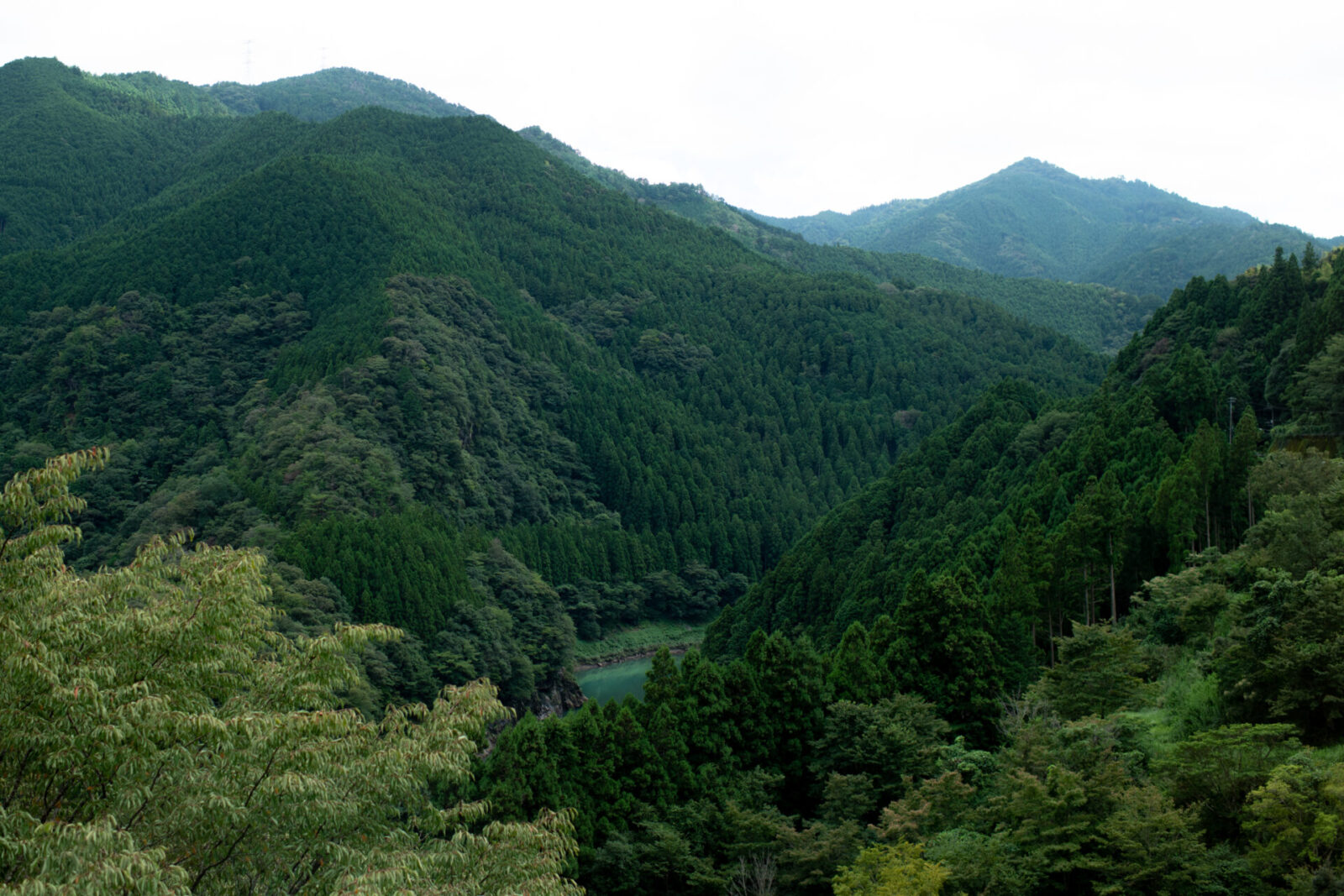
The step following the soaking and fermenting of the tea leaves is sun drying. Naturally, the sun needs to be out in order to do this.
This meant that we had to carefully check the weather report to make plans for our trip. The earliest we could plan ahead was two days in advance, and if the weather report changed on our scheduled day, we had to cancel.
As such, our schedule to travel to Kamikatsu Town was decided on a very short notice.
In order to start working on the Awabancha first thing in the morning, we would have had to leave Tokyo and arrive in Kamikatsu the day before. However, it was only in the morning of the day before that we received a call from the Kamikatsu Awabancha Tea Association.
“Let’s work on your Awabancha tomorrow!”
Our team of editor, writer, and photographer hastily prepared for the trip and we managed to arrive in Kamikatsu Town by that evening.

A typhoon had just passed through Kamikatsu the day before so the air was humid and the wind still felt wet and warm. It was still raining on and off, so we were not certain if we would be able to sun dry the leaves until the next morning.
We prayed that our trip would not end in vain and for the weather to participate the next day.
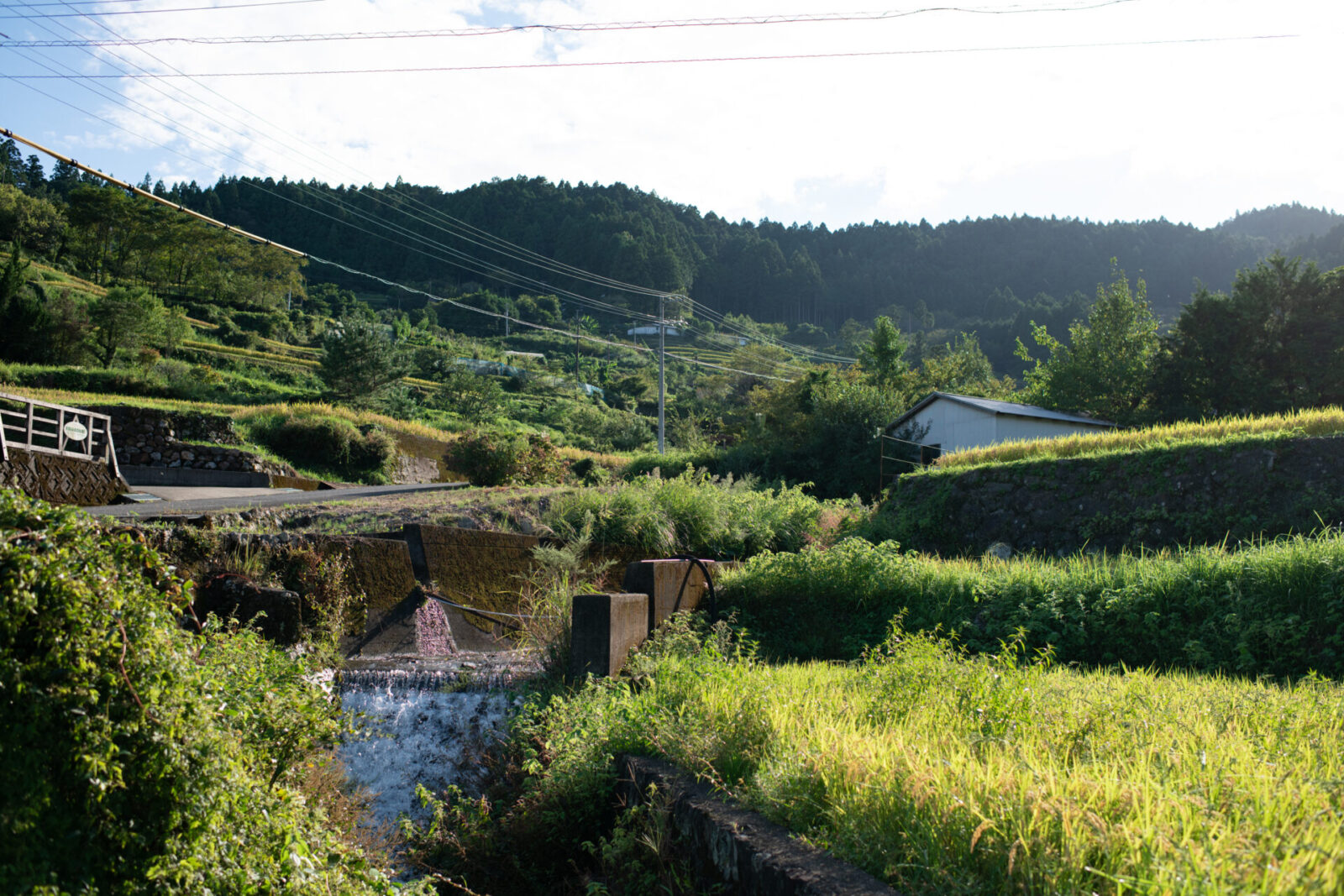
On the morning of our scheduled work day, there was still a slight drizzle of rain, but the forecast stated that it would clear up and the sun would be out before noon.
With a ray of hope in our hearts, we headed to the farm house where we would meet with the people of the Kamikatsu Awabancha Tea Association. When we arrived, the memory of the strenuous labor during our last visit when we worked in the summer heat to harvest, rub and soak the Awabancha leaves, came back to us and we mentally prepared ourselves for the day ahead.
A few minutes later, Hiroshige Takagi, president of the Kamikatsu Awabancha Tea Association and the farmer who worked with us the last time, arrived in his truck.
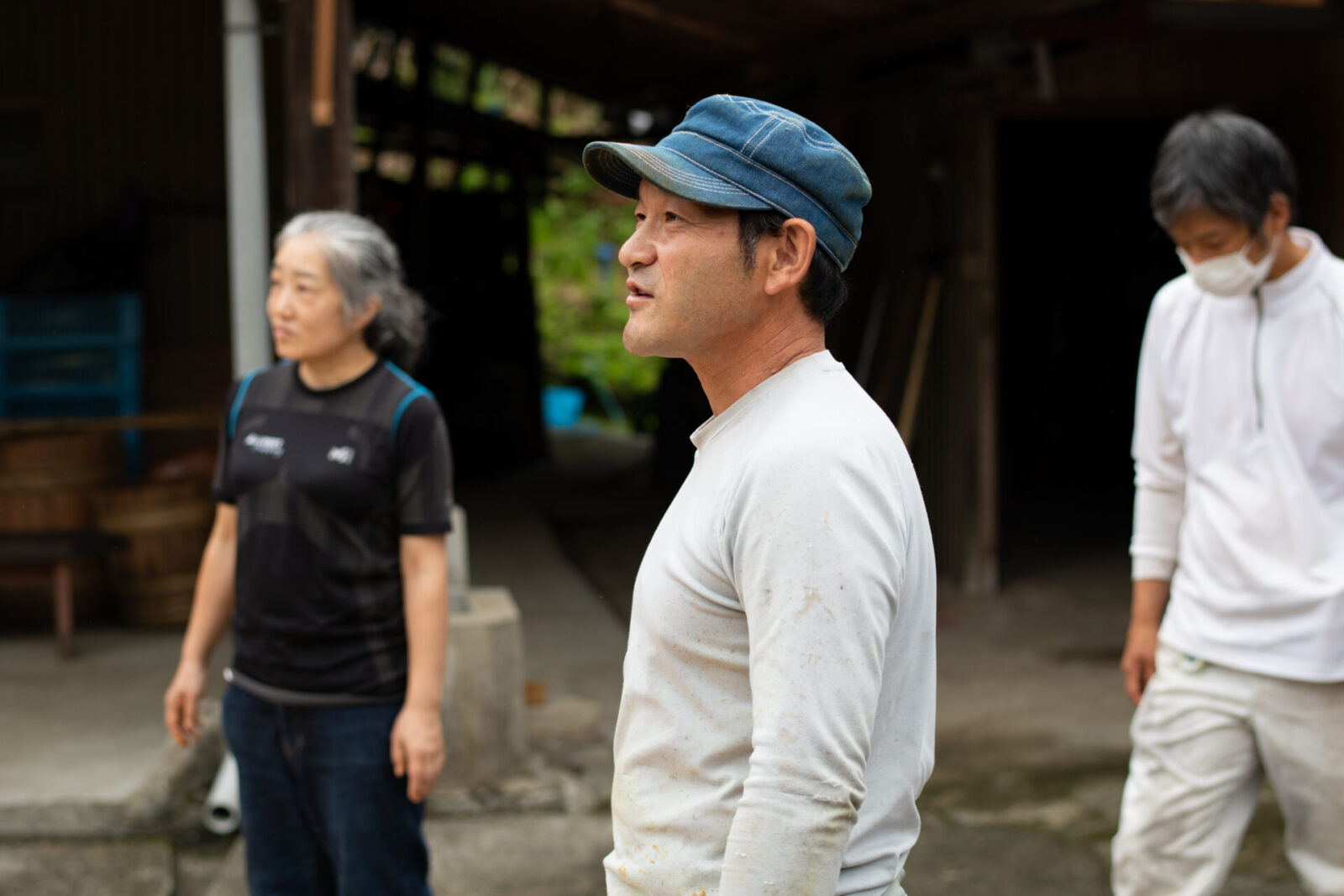
While greeting us, Takagi stepped out of his car and looked up at the sky and paused. After a few moments of quiet contemplation, he turned to us and said,
“Okay, let’s get to work.”
We later heard that the producers of Awabancha are all a little tense this time of year. There was a lot of rain and not many days were suitable for sun-drying the tea, so the farmers were constantly on edge and checking the weather.
On this particular day, Takagi was also sun-drying his Awabancha leaves from 4 a.m. at Takagi Farm, a short distance away. He had taken time out of his busy schedule to help us.

“Alright, everyone get together. Let’s start.”
The time had finally come. We would find out whether our Awabancha fermented successfully and if our tea would taste good or not. We did as Takagi asked and gathered in front of our team’s Awabancha tea barrel.
Carefully removing tea leaves from the barrel
Step 6. Remove from barrel
The first step of the day was to remove the lacto-fermented tea leaves from the barrel.

We had been following updates on the progress of fermentation of our barrel, which the Kamikatsu Awabancha Tea Association posted on their Facebook page, so when we saw the brown and slightly grotesque liquid (tea juice) that was oozing out from around the lid, we were not caught by surprise.
However, when we approached the barrel in person, the smell of the fermented leaves that reeked out from the barrel was much stronger than what we had imagined.
We got to work and first used a plastic pump to remove the excess water that surrounded the lid. The source of the strong and potent smell was the tea juice, and it is vital to remove every last drop.
If a single drop of this liquid enters the barrel as you open the lid, it will be absorbed by the tea leaves below and develop an unpleasant taste.
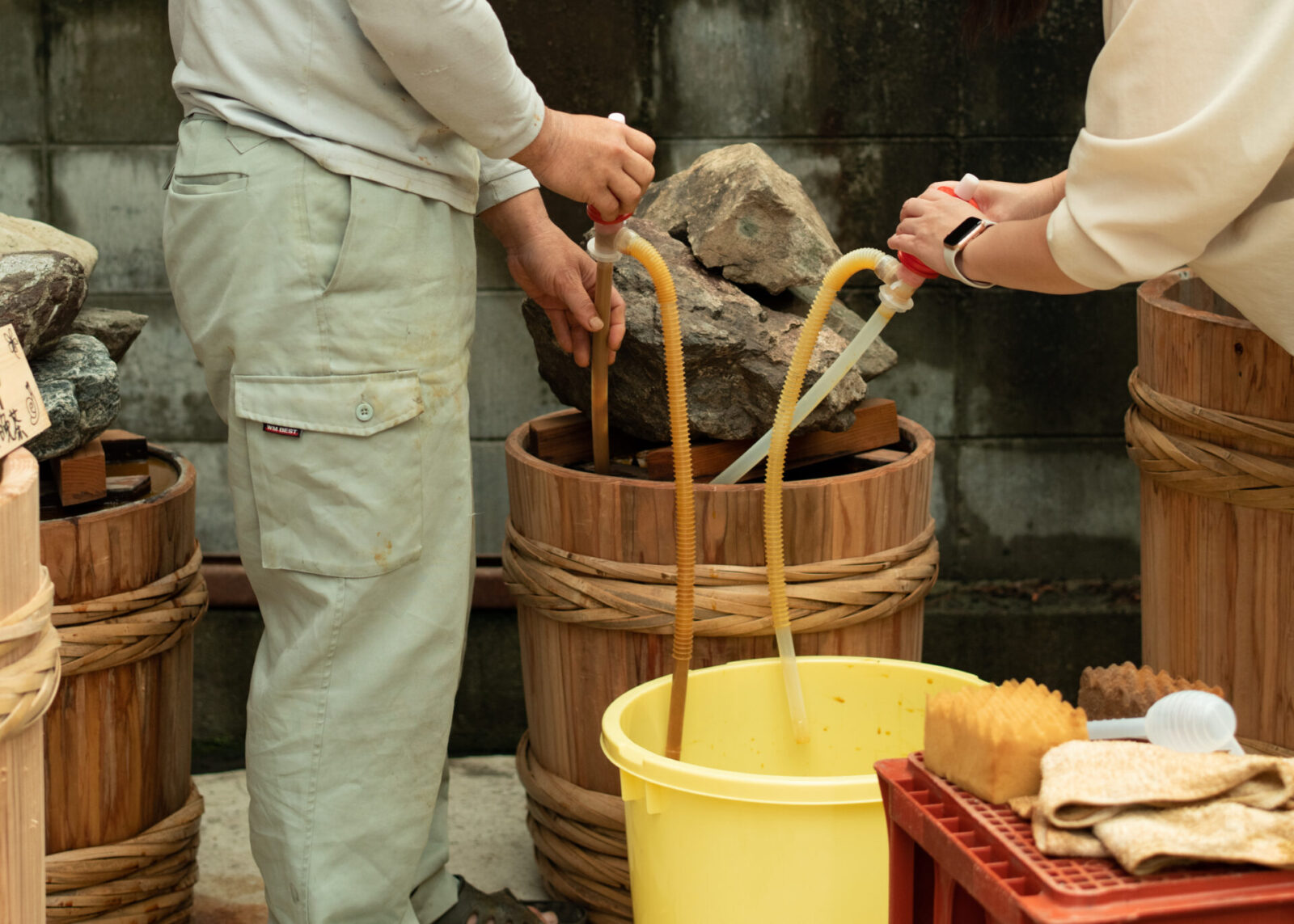
We were tempted to remove the rock used to weigh down the lid for this process, but removing the rock will also cause the rancid tea juice to enter into the barrel and get absorbed by the tea leaves, so it was out of the question.
Takagi said, “My teacher always told me that you must be most careful when removing the lid.”
This process directly affects the final flavor of the Awabancha, but it is difficult to focus while working in the sight of the rotten tea juice and smelling its potent stench.
Takagi laughed as he said, “This is my least favorite part. You need to empty your mind in order to get through it.”

Before finally removing the lid, the final droplets of the tea liquid are removed with a sponge. Even among the stench of the tea juice, when the lid was finally opened, the air was filled with a more pleasant sour smell of fermented tea leaves and that brought us joy.
After removing the exposed excess leaves and the cloth used to cover the inside, the tea leaves finally revealed themselves.

The top layer of leaves had a slightly yellowish tint and looked a bit like pickles. The next moment, Takagi started removing a good chunk of leaves on top.
The tea leaves on top, where the unpleasant smell remains slightly, is called “Kuchicha,” or “mouth tea.”
These leaves are removed but are kept in order to be made into a separate tea. It becomes a tea with a slightly more distinct flavor than regular Awabancha tea, but we were told that some people actually prefer it.
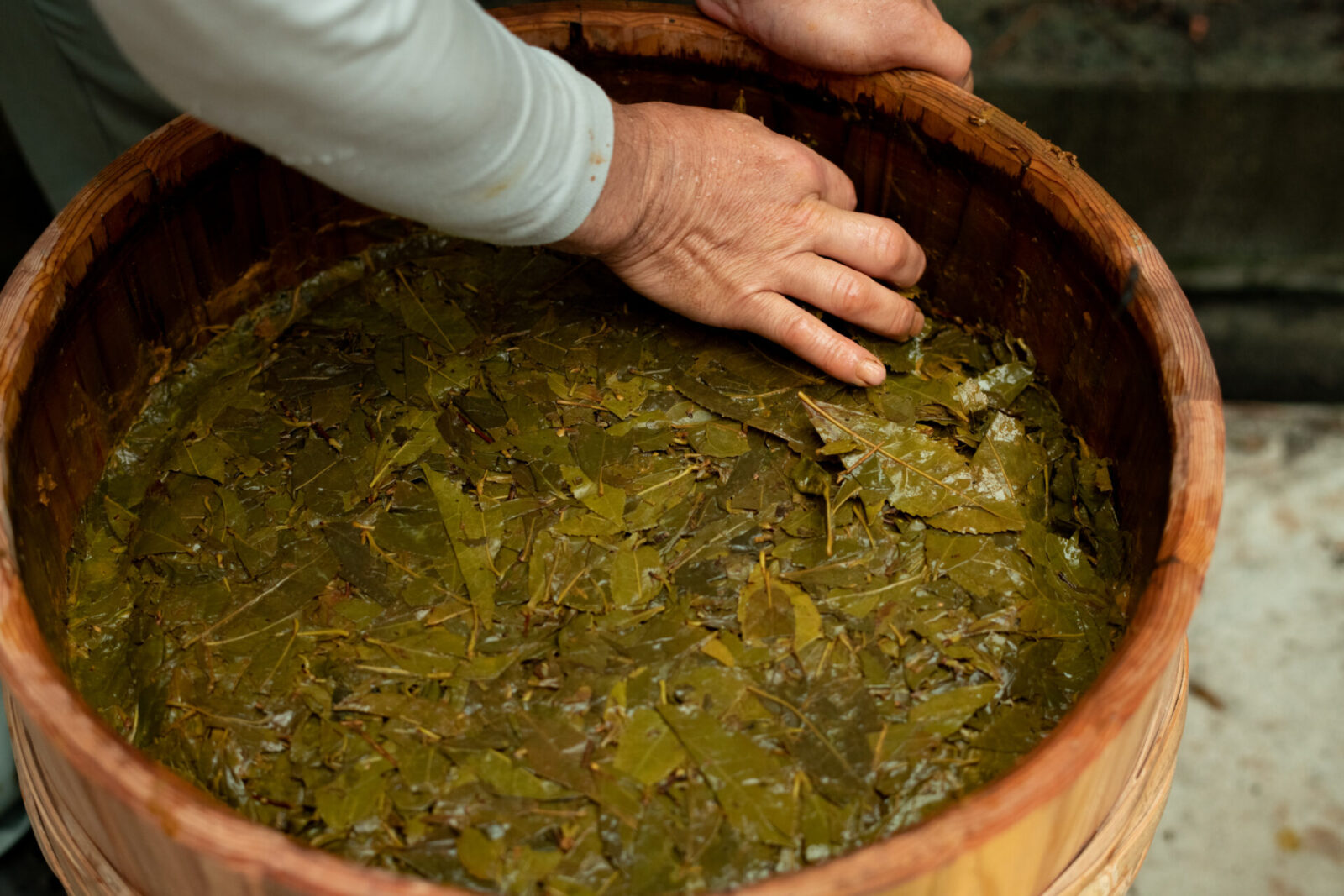
The point in which the tea leaves go from being suitable for Kuchicha or Awabancha is judged based on the aroma of the leaves.
Takagi says, “It’s a pretty primitive method, but it is the most accurate and reliable way to tell!”
As Takagi said, about one-third of the way down the barrel, the aroma of the tea leaves clearly became that of the Awabancha that we were familiar with.
As we approached the bottom of the barrel, the aroma became even more fruity.
Various aromas reached our nose as we removed the tea leaves from the barrel which it sharpened our senses.
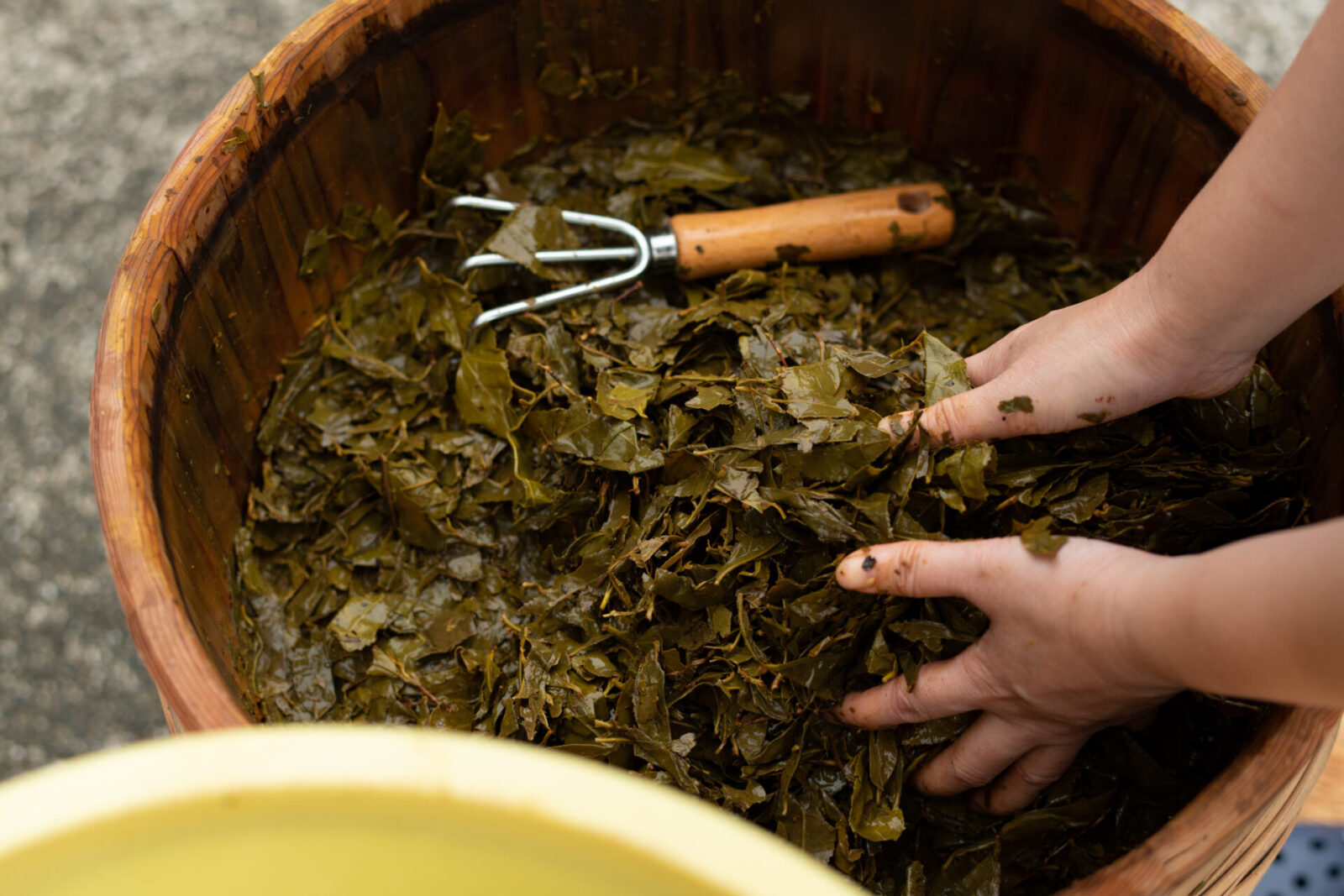
The step of removing the tea leaves from the barrel was the most strenuous and hard step of that day, but it was also the most important.
When we looked over at Takagi’s hands, they had turned completely yellow. Takagi laughed as he said, “My hands always turn this color this time of year. My nails remain yellow for about two months.”
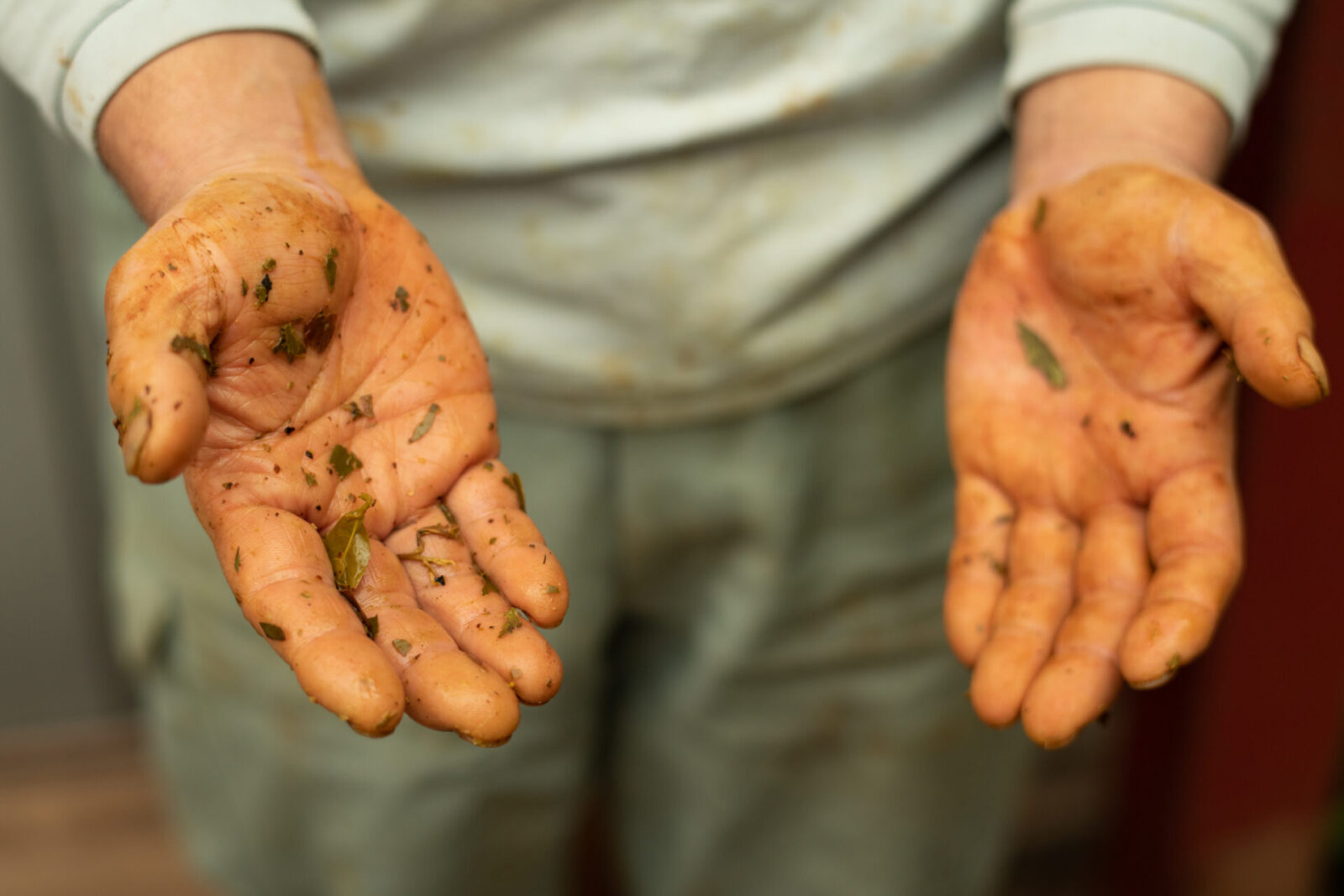
Pulling apart the balls of tea leaves before sun-drying
Step 7. Drying in the sun
The next step in the Awabancha production process is drying the tea leaves in the sun. A thick cloud was still covering the sun at the time unfortunately, but we carried on with the work.
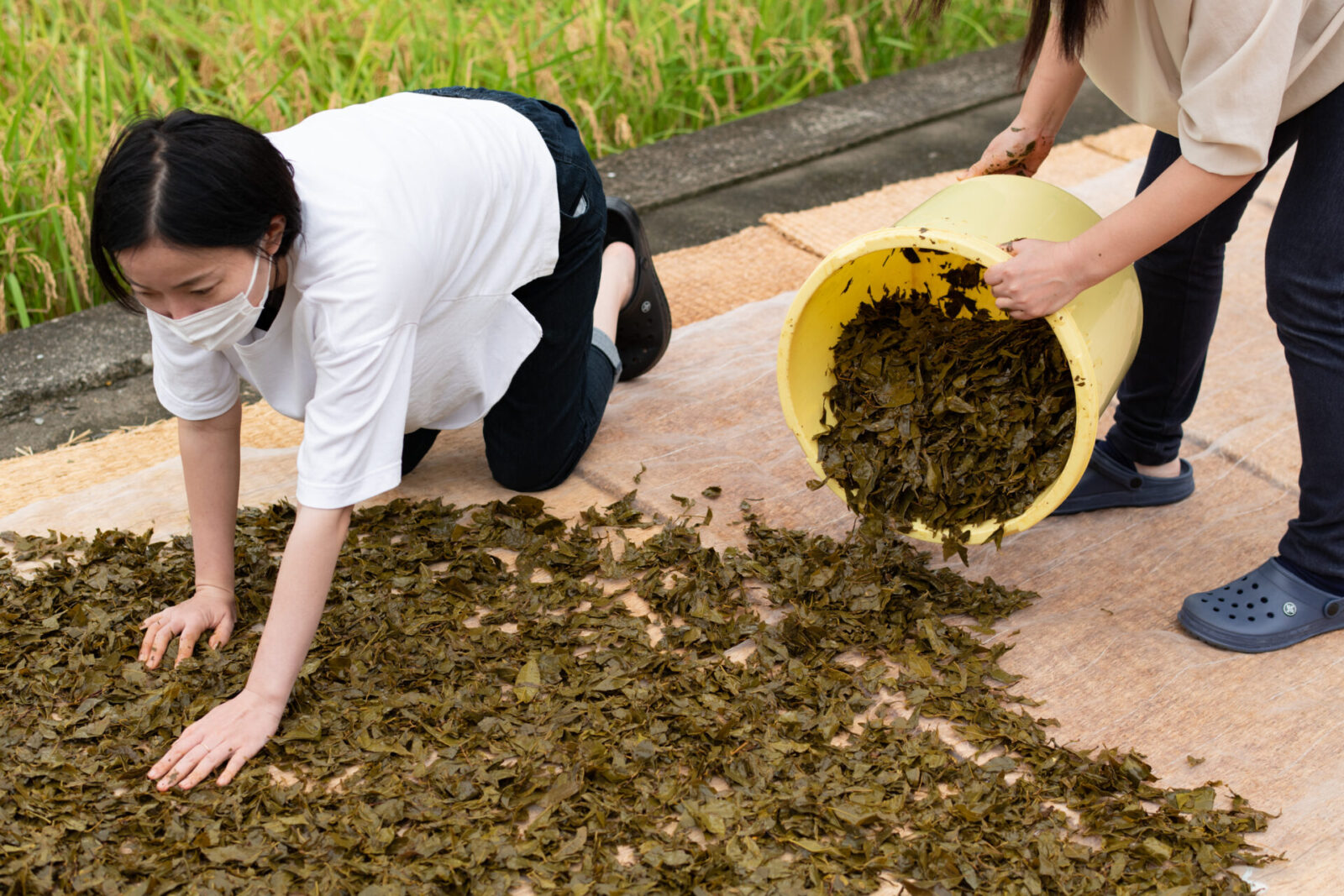
Goza, or straw mats, were laid down along the concrete paths of the farm house and a gardening net was laid on top of the mats.
Next, we poured the tea leaves over the mats and spread them out with a rake.
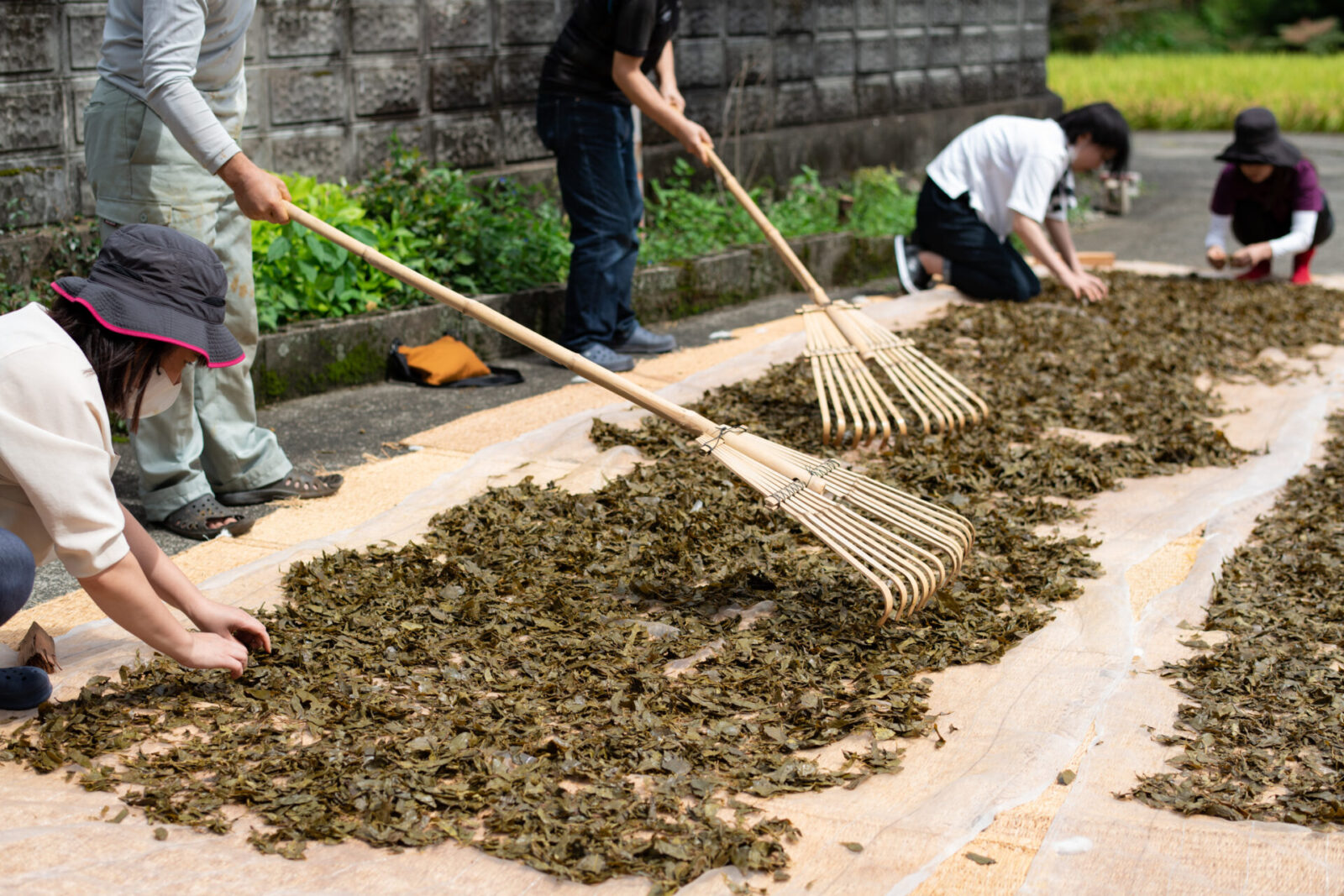
We also gently loosened the tea leaves by hand so that they would be evenly spread out on the mats.
The tea leaves become compressed into little balls in the barrel because they are folded and layered on top of each other.
Leaving the tea leaves in balls prevents them from drying evenly and will cause mold later on. For this reason, we scavenged through the piles of tea leaves for these balls and took them apart one by one. Although time-consuming, this is one of the key steps to successfully sun-drying the tea leaves.

Another key point in successfully sun-drying the leaves is to avoid exposing one area to too much sun. Over-exposure can cause the leaves to turn red and ruin the tea’s aesthetics.
“Good quality Awabancha will go from a yellow color to a blue color, and then finally turn black. Awabancha that turns red is wilted.”
The upper leaves of the barrel that will become Kuchicha were also spread out on the mat and sun-dried. Evenly spreading out a total of approximately 30 kilograms of tea leaves was not an easy task.
On top of that, no matter how long you dig through the spread out leaves, you seem to find endless balls here and there to take apart.
Nonetheless, the more we worked and put effort into the tea leaves, the more our feelings of appreciation and anticipation for the tea grew.
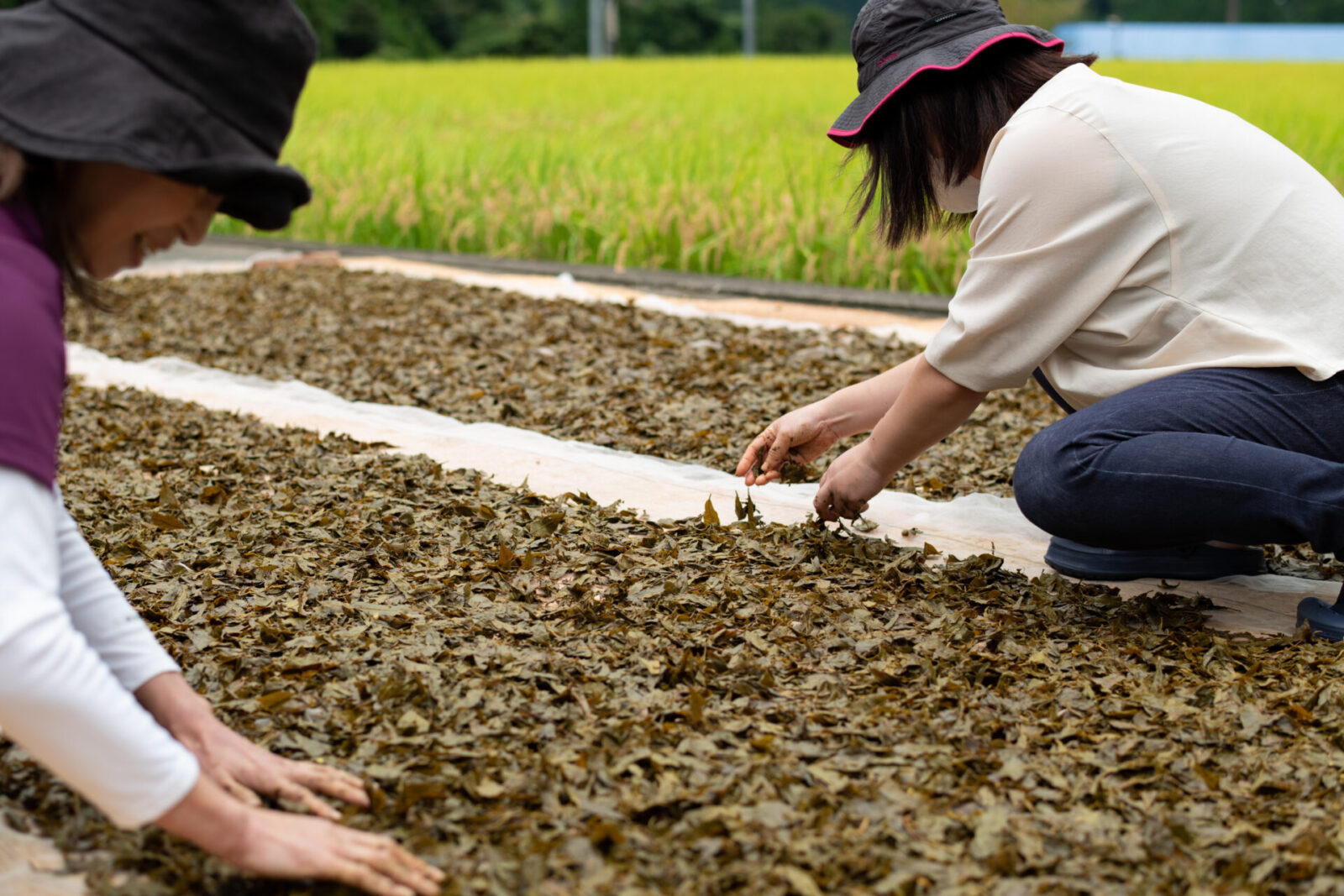
While there was no end in sight to the work, we chanted words of encouragement to the Awabancha leaves in front of us so they would become delicious.
The power of the sun makes Awabancha
After spreading out most of the tea leaves, we took our lunch break. When we returned, the sun had finally come out!
We all rejoiced and welcomed the much awaited sunlight.

Behind the mats where the Awabancha leaves lay to dry, golden ears of rice waiting to be harvested swayed in the wind.
The beautiful teascape uplifted our fatigued bodies.
Now that the tea leaves were under direct sunlight, the pace at which it dried increased significantly. The tea leaves became slightly warm to the touch, and a roasted fragrance that was not present before began to fill the air.
This must be what Takagi referred to as “good quality Awabancha.” Under the bright sun, the tea leaves began to turn a shiny black color.

After about three hours of drying in the sun, the surface of the tea leaves began to dry. At this point there is another hands-on step that needs to be done.
We lifted the nets to gather the tea leaves in the middle. Next, we shook the net to mix up the leaves.
After the tea leaves are mixed, they are spread out by hand once again, but the dry tea leaves are more prone to breaking. It is very rare for a tea leaf to fully dry while preserving its whole shape.
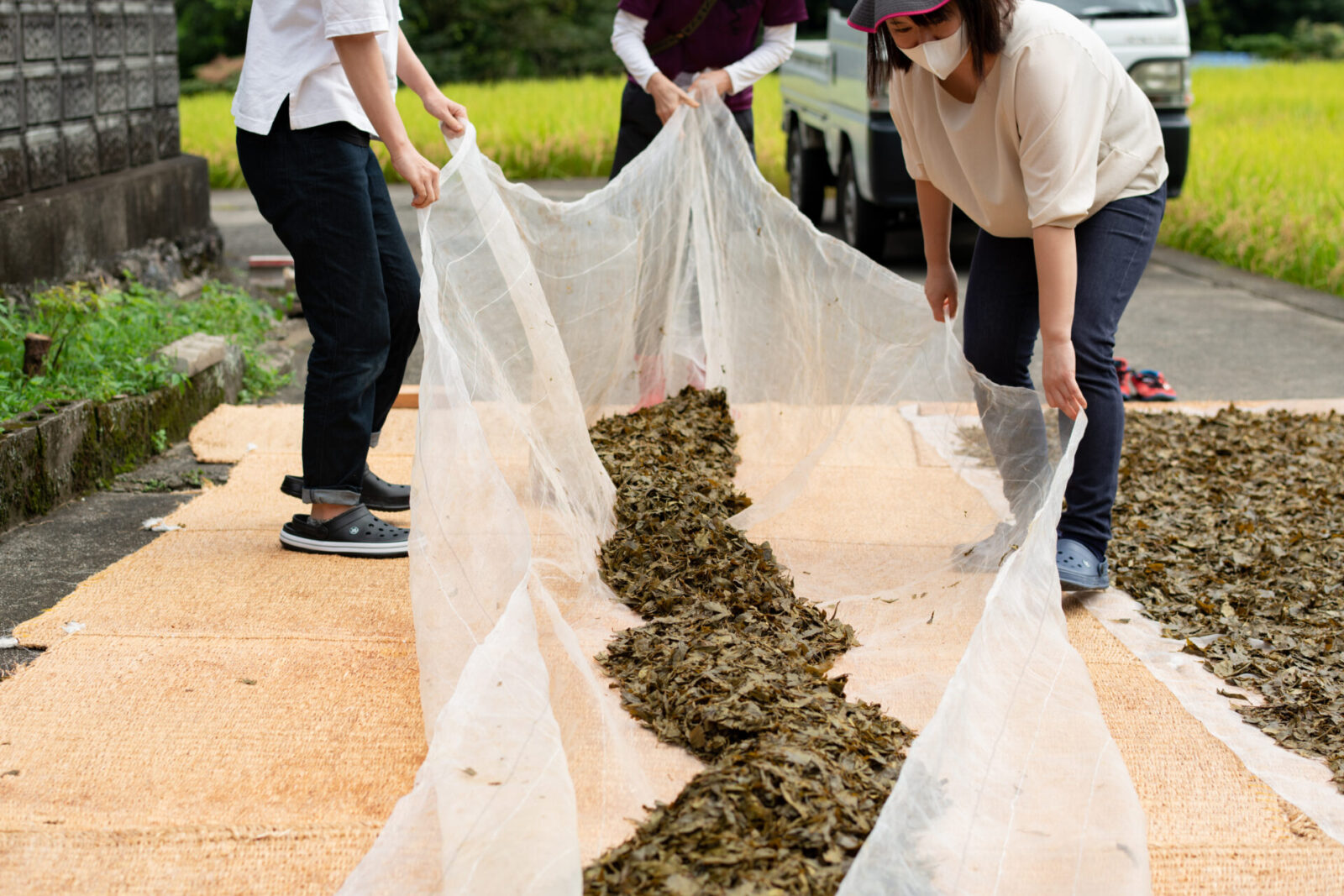
The tea leaves are dried for a total of two to three days. Moisture is the tea leaves’ biggest enemy so they are moved indoors early in the evening before the afternoon dew falls. In the morning, they are taken back out and spread out once again to dry in the sun.
Trying out 1-day dried Awabancha
After the first day of sun drying the tea leaves, we had a budding question.
What does the Awabancha leaves taste like after only one day of drying?
We asked Ms. Satoko Matsumoto, a member of the Kamikatsu Awabancha Tea Association, but she told us that she had never tried it before.
For our DIG THE TEA Experiment team, this was a perfect opportunity to explore the unknown. Together with Ms. Matsumoto, we decided to give it a try.
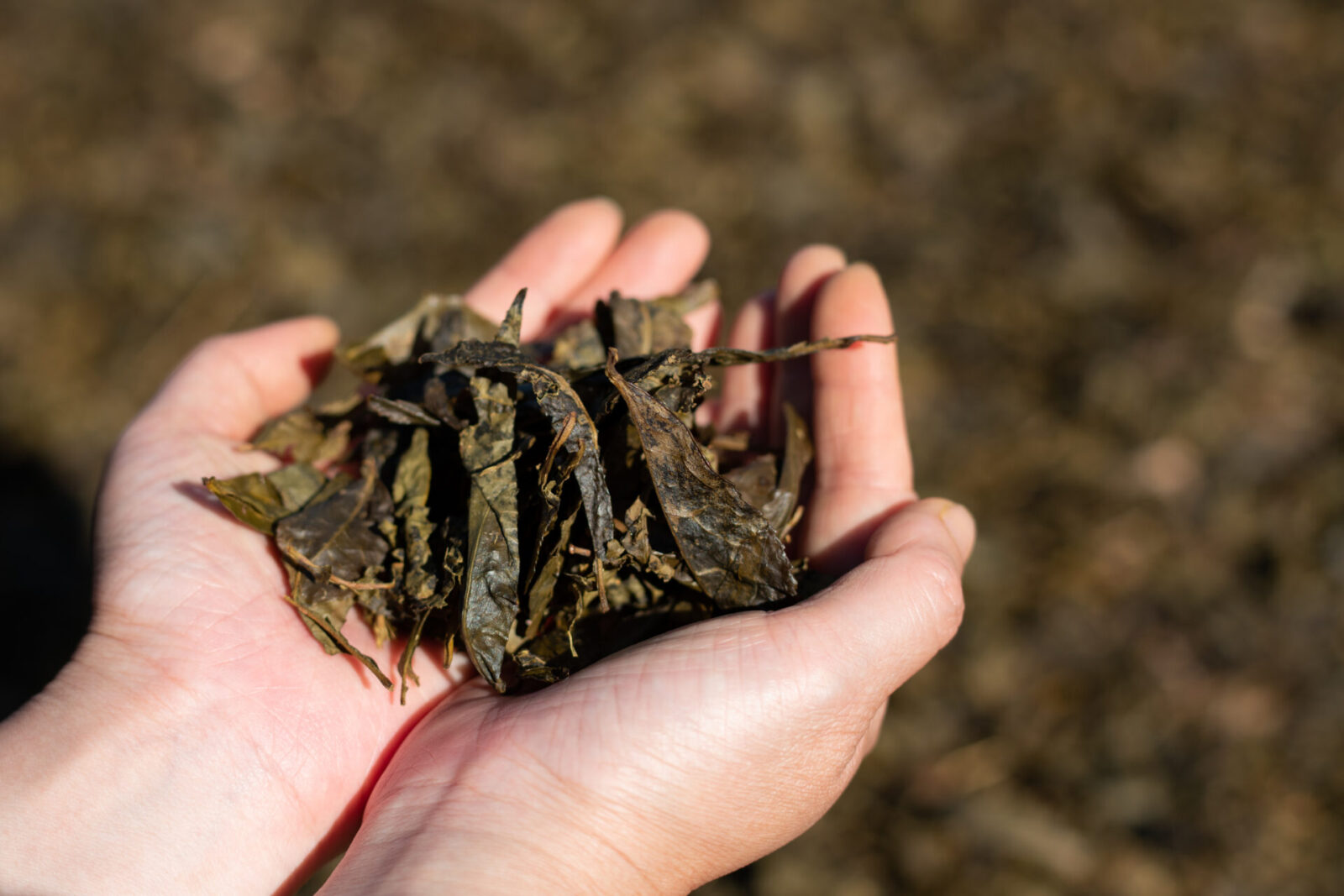
We picked a handful of Awabancha directly from the straw mats (about 3 to 4 grams) and put them in a teapot. Then we poured 500 milliliters of 80 degrees Celsius hot water over the half dried tea leaves and waited for two and a half minutes.
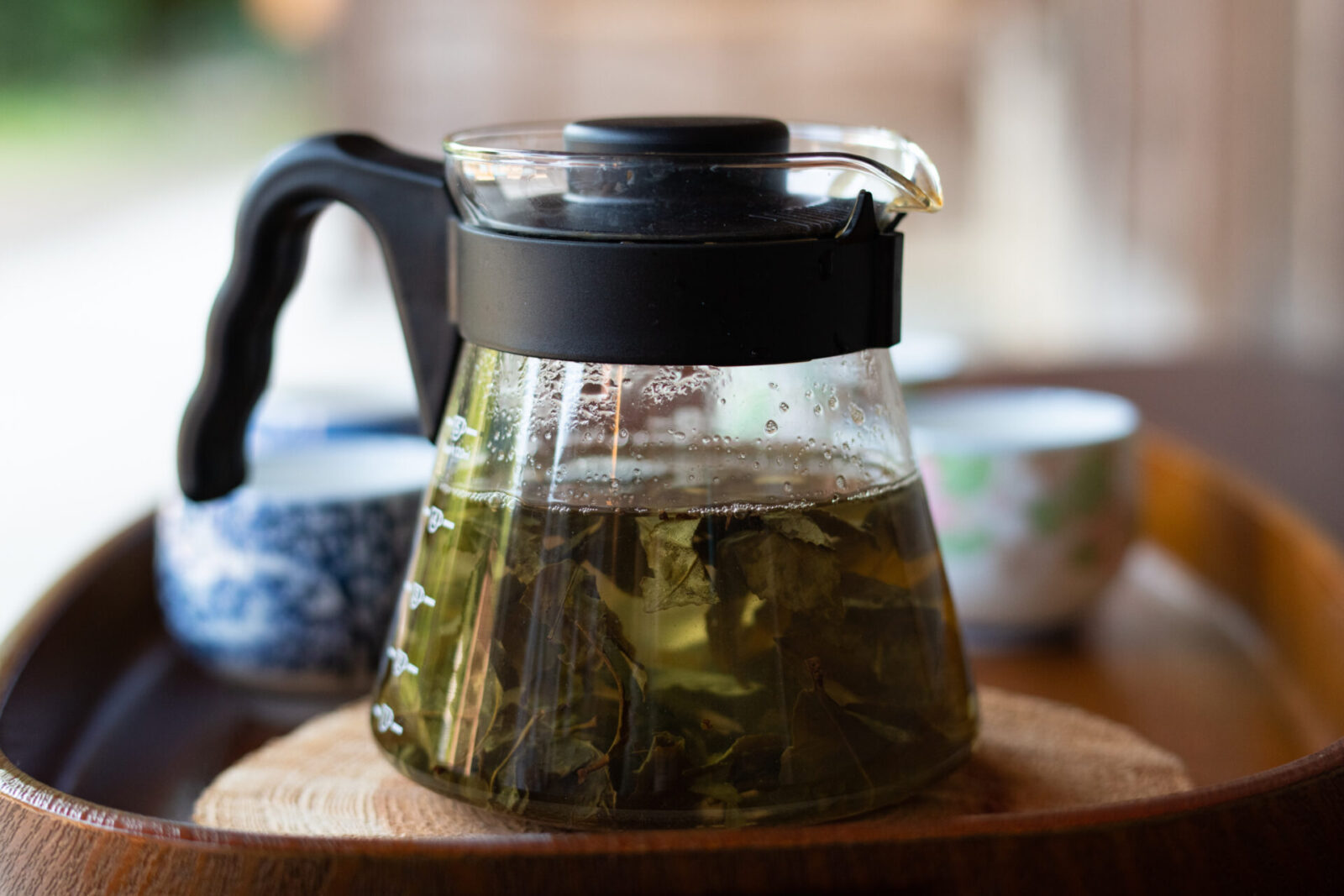

As we poured the tea into some tea cups, we found that its color was somewhere in between green and yellow. We brought the tea up to our mouths with anticipation. The aroma was definitely that of Awabancha and so we took a sip.
“Delicious!”
All of us, including Ms. Matsumoto, stated in agreement. The tea still had the flavor of young tea leaves, but not in an unpleasant way and it had a very enjoyable fruity tea flavor.
We poured some more hot water in the same pot and waited for five minutes for the second infusion. The second cup of tea had an even fuller aroma.
Being able to experiment with tea while experiencing the production of Awabancha was definitely one of the perks of participating in this program.
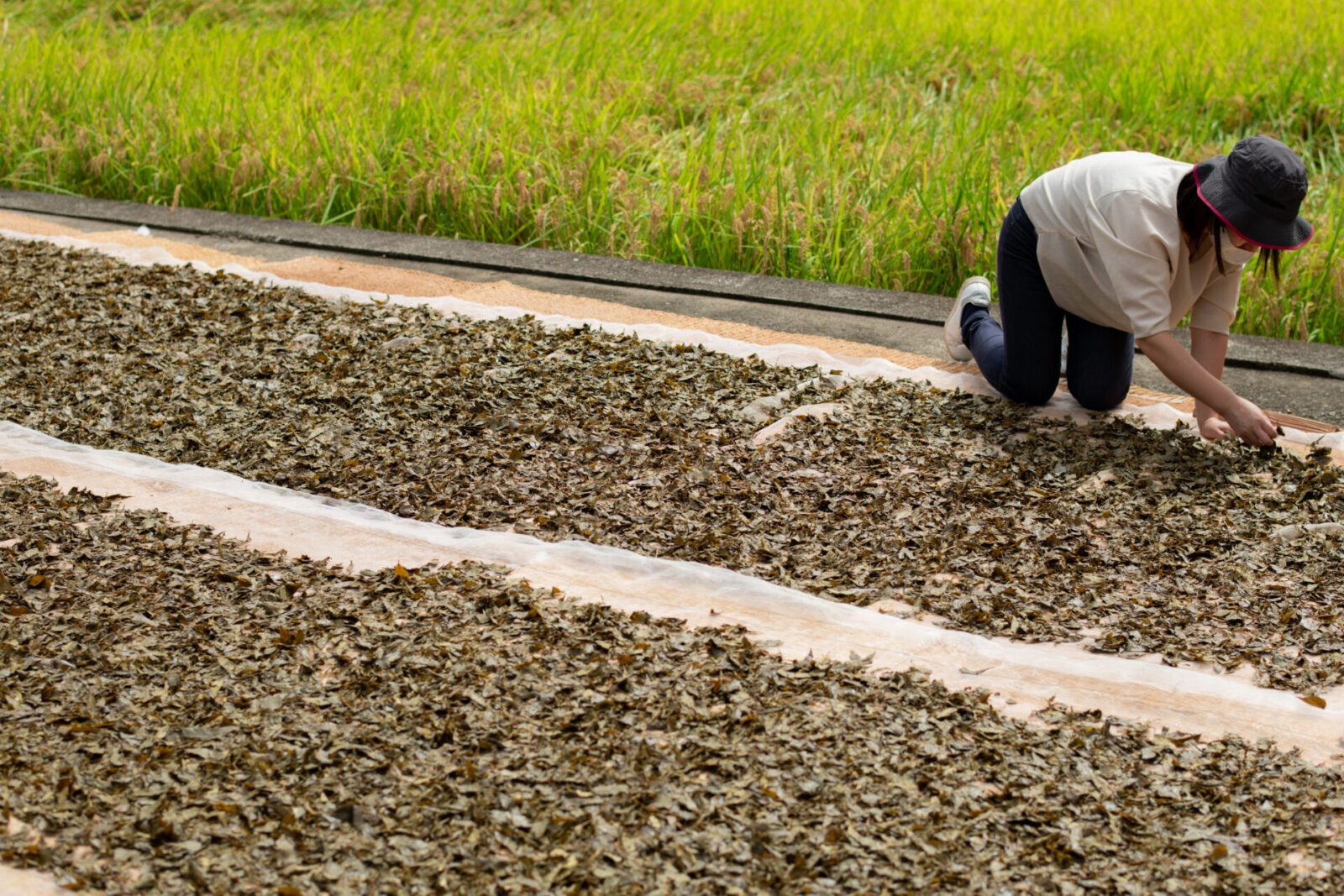
Occasionally, a sudden gust of wind would blow some of the tea leaves away while they were drying on the mat. Although it was only a few leaves at a time, after all the painstaking work we put into them it was disheartening to see even a few of the tea leaves be blown away. In fact, it’s quite fascinating how much one becomes attached to the tea leaves after being a part of its production.
At 4:30 p.m. in the afternoon, we gathered the tea leaves and stored them away indoors, and that was the end of that day’s work.

The members of the Kamikatsu Awabancha Tea Association would look after our tea leaves for the remaining days of sun drying, so our team headed back to Tokyo.
After just a single day of drying in the sun, our Awabancha proved to be very delicious so our anticipation towards the final product grew high as we departed Kamikatsu.
Sorting the leaves, and the battle continues
Step 8. Sorting and packaging
The final step in the process of making Awabancha Tea was sorting and taste-testing the final product. These steps were done in our Tokyo office.
Two large cardboard boxes from Kamikatsu filled with the sun-dried tea leaves arrived in our office. Our production of Awabancha started with about 30 kilograms of tea leaves, but after drying they weighed about 7.8 kilograms.
Ms. Matsumoto had taught us how to sort the tea leaves while we were in Kamikatsu, so we set about sorting them according to her teachings.
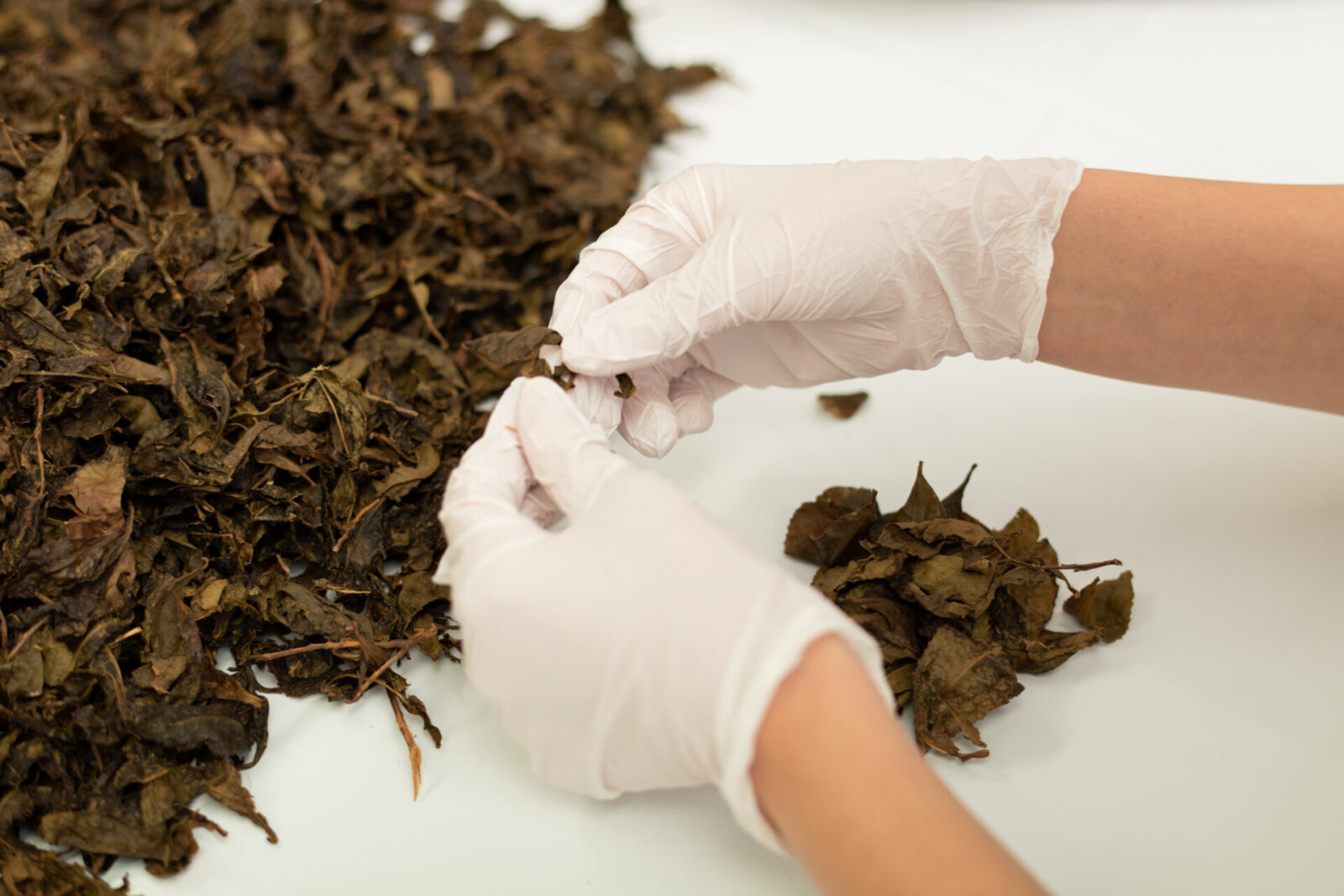
First, we covered a table with a white tablecloth and put the tea leaves in a pile in the middle. Any leaf that is discolored or in a cluster was removed.
Next, we sorted the tea leaves into groups: 1. large leaves, 2. broken and crumbled leaves, and 3. stems.
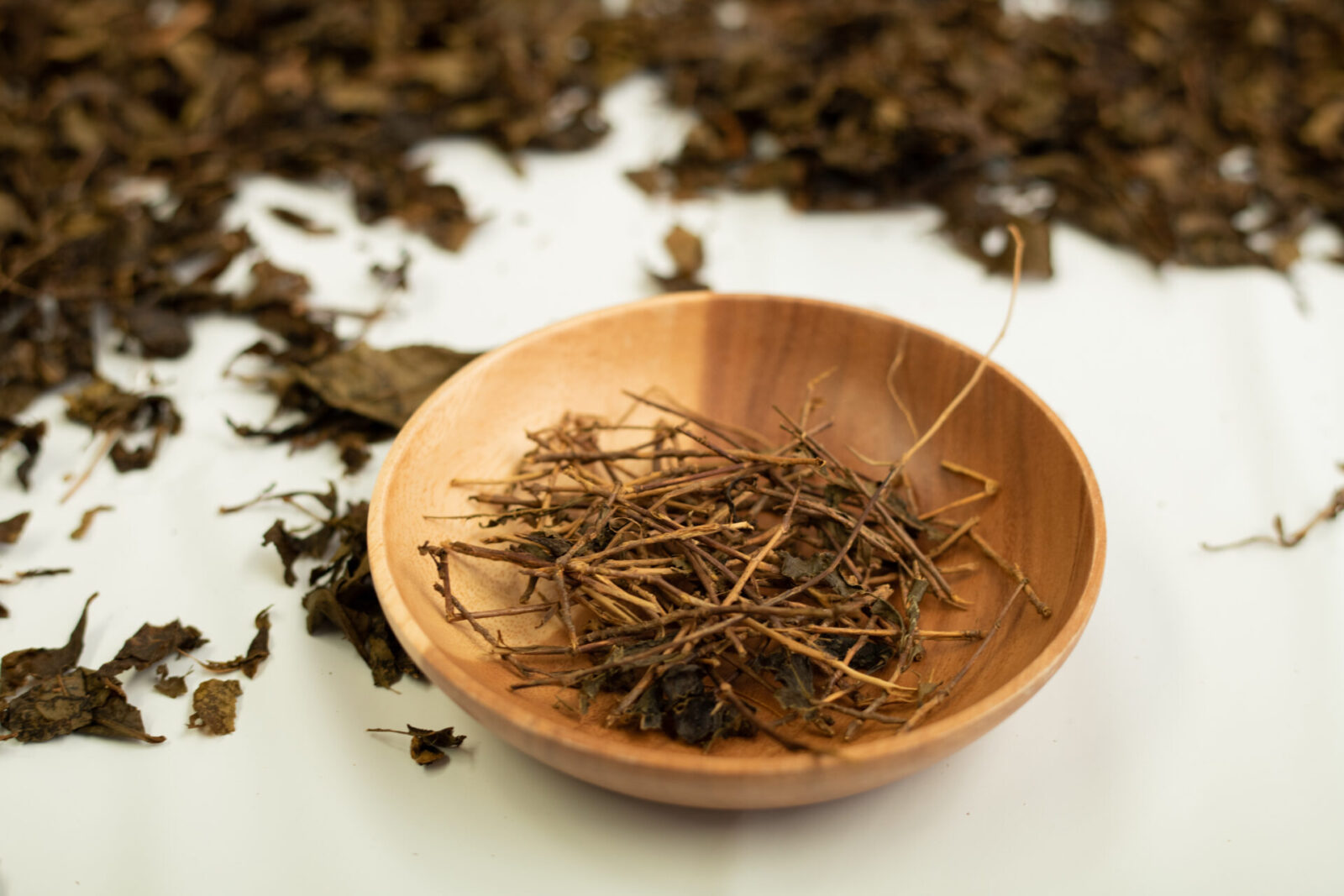
The stems will become “Kukicha,” meaning “stem tea.”
The large leaves are generally distributed into the market as tea leaves, while the broken and crumbled leaves are packaged into tea bags. The stem tea is sometimes sold as its own product under the name of Kukicha.
The final step is to sift the leaves through a sieve to remove the ground up leaves and powder.
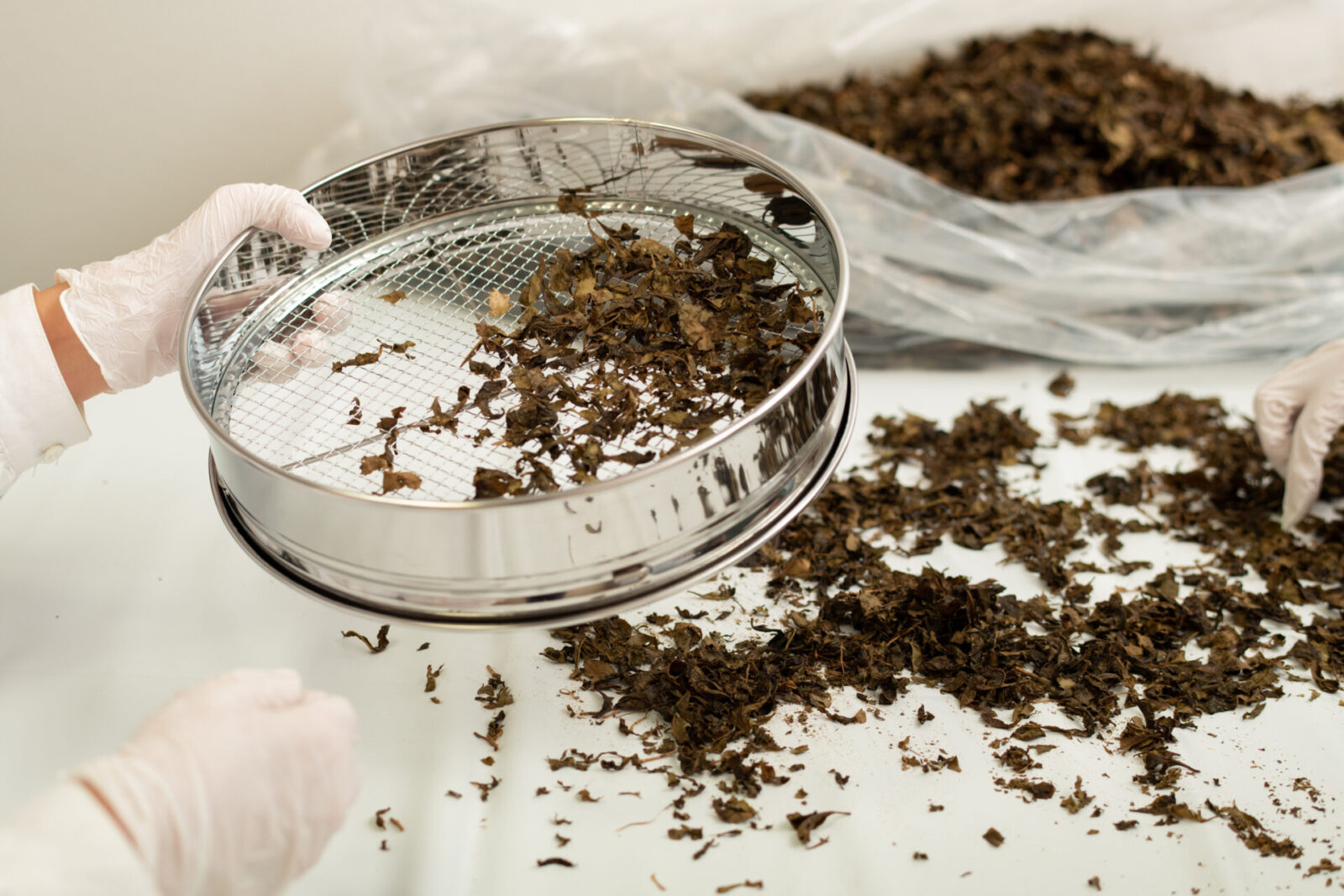
The DIG THE TEA team was fully prepared with hair caps and gloves to make sure hair and other debris don’t get mixed in.
Because all of us were unsure about the sorting criteria at first, the sorting process started out slowly. However, we soon realized it would take us forever if we aimed for perfection, so we prioritized speed.
In Kamikatsu, the sorting process is a social event where members of the community gather and chat while they work.
We found that the same was true in our office as we engaged in chit chat while working on the pile. Soon, there was a sense of unity in the group.

It took about five hours of sorting non-stop without breaks to get through all the tea leaves.
Takagi had told us that it “should take about two hours if you work with two to three people.” Ultimately, it took us twice that time.
Nonetheless, we completed all the processes in the making of our Awabancha tea. We are currently working on designing the packaging DIG THE TEA’s original tea. When that is ready, we will move onto the final packaging process.
After we finished sorting, we prepared to taste test our tea right away. It was the moment we had all been looking forward to.
The much anticipated taste test
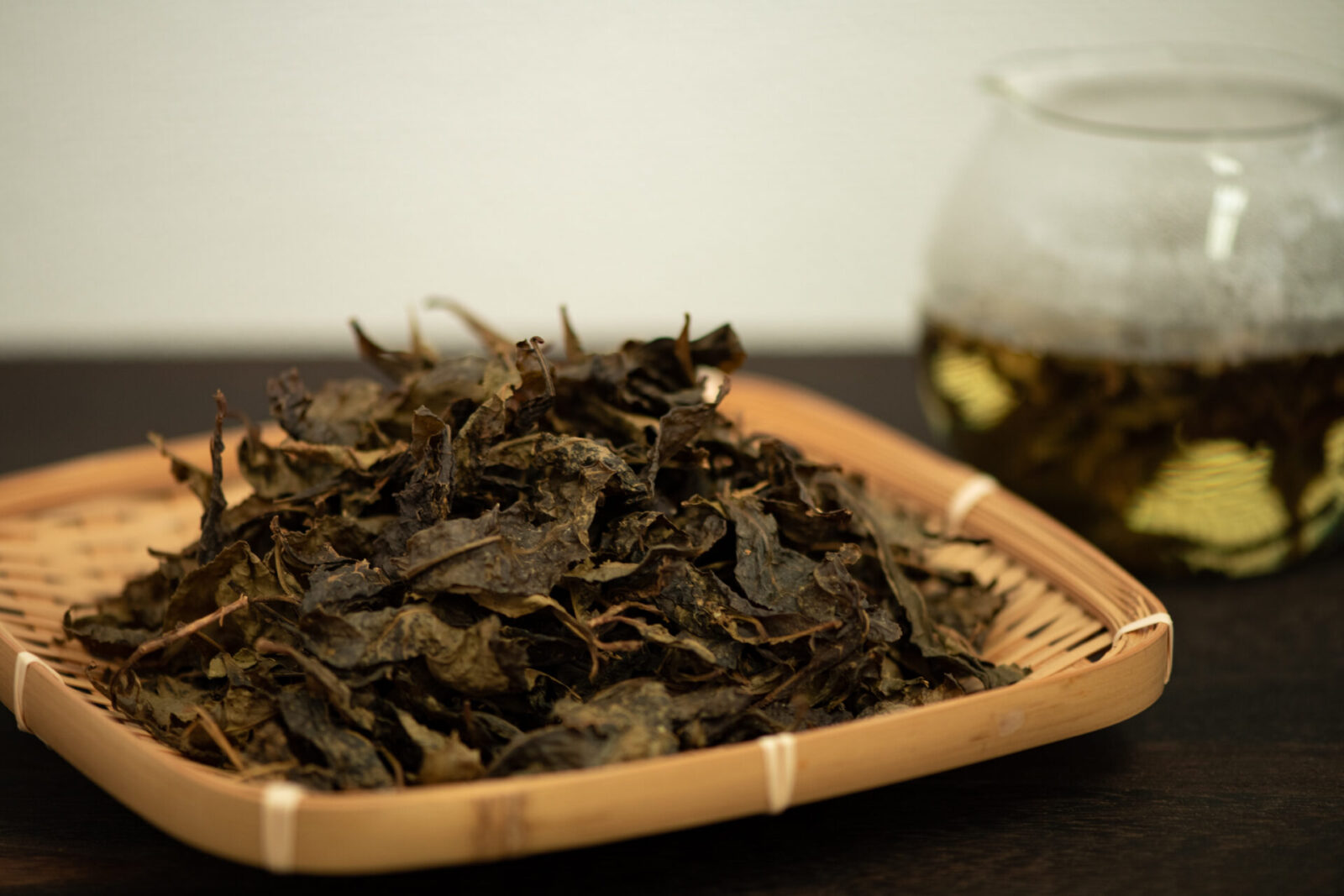
We decided to taste each of the tea groups, from the large leaves, stem tea and the Kuchicha.
As we did for the tea that we brewed in Kamikatsu, we brewed 3 grams of tea in 500 milliliters of hot water, and adjusted the volume based on the size of our tea pot.
Beautiful colors and full of flavor
First, we started with the large leaves to make regular Awabancha. The color of the tea was a wild and beautiful yellow, just as we had hoped.
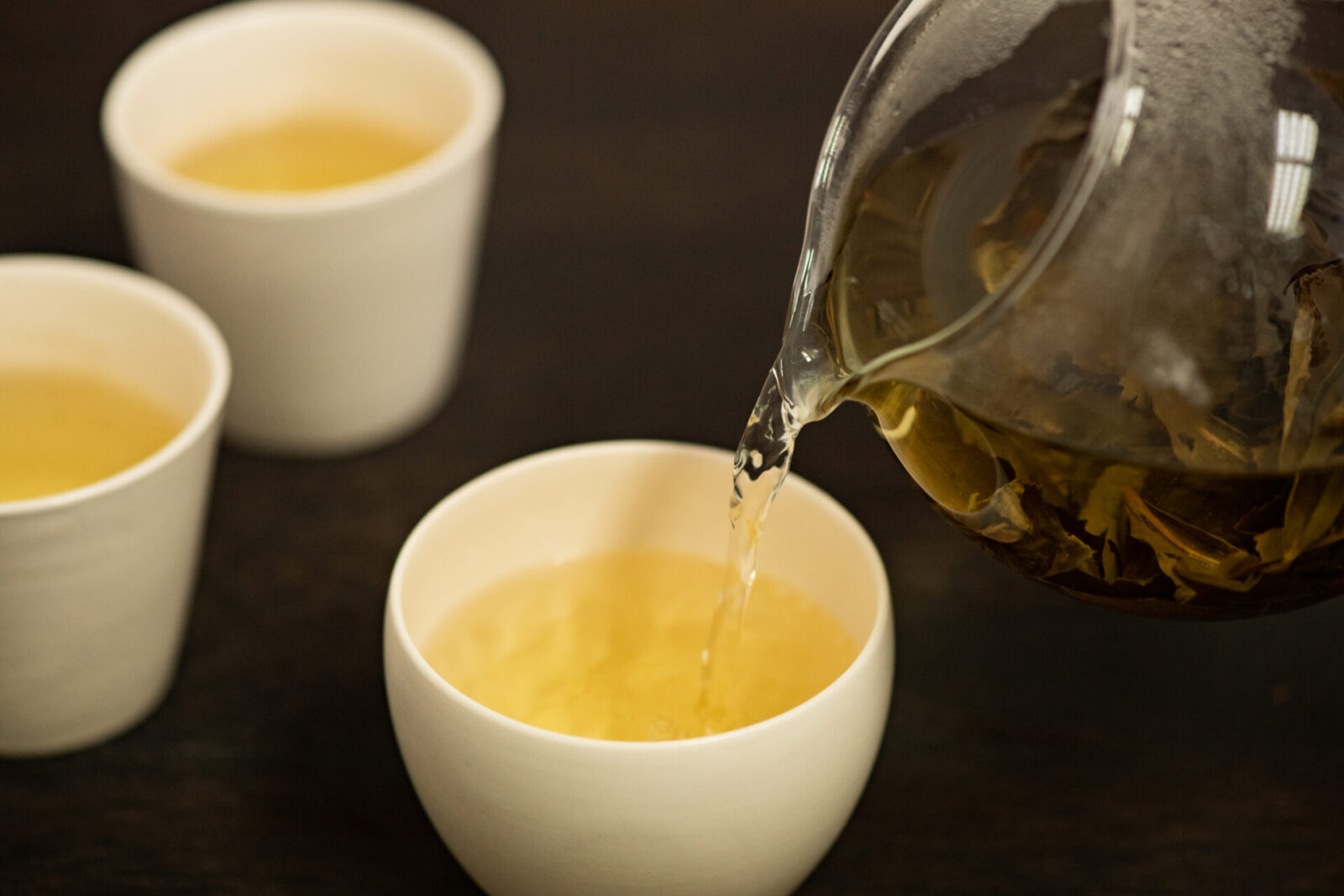
The aroma of the tea is not strong until it reaches your nose. However, the moment you take a sip and it enters your mouth, the flavor spreads with great vigor. In the next sensation you taste the sweetness of the tea which lingers gently in your mouth.
One of the DIG THE TEA team members described it as being similar to Chinese white tea.
It had a deeper and more matured flavor than the tea we brewed after just one day of sun drying. The result was just what we had hoped for in our Awabancha tea. A flavor that melts our hearts.
Surprise of the Kukicha
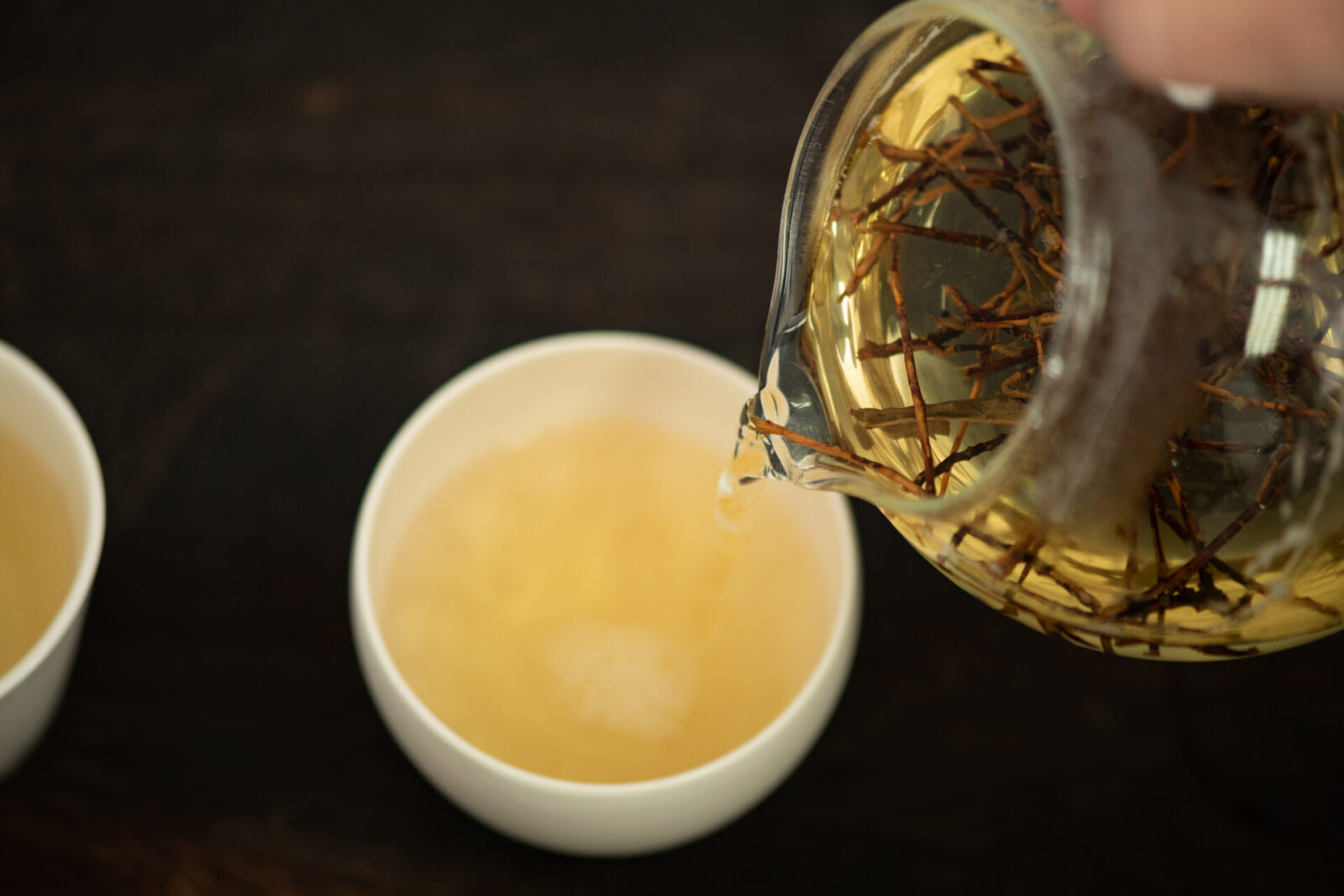
Next, we tried brewing the Kukicha, which looks like little twigs.
Despite being made up of only stems, it had an unexpectedly robust yellow color. Although it was not as delicious as the regular Awabancha, it had plenty of flavor and sweetness. A slight bitterness added to its unique flavor. Overall, stem tea is very well rounded and can be thoroughly enjoyed as a tea.
Kuchicha is for those who like tea with a punch
The final tea we brewed was the Kuchicha, which still had a slight hint of the pungent tea juice on top of the fermenting barrel. The smell intensified when we added hot water to the tea, so it required a bit of courage to take a sip.
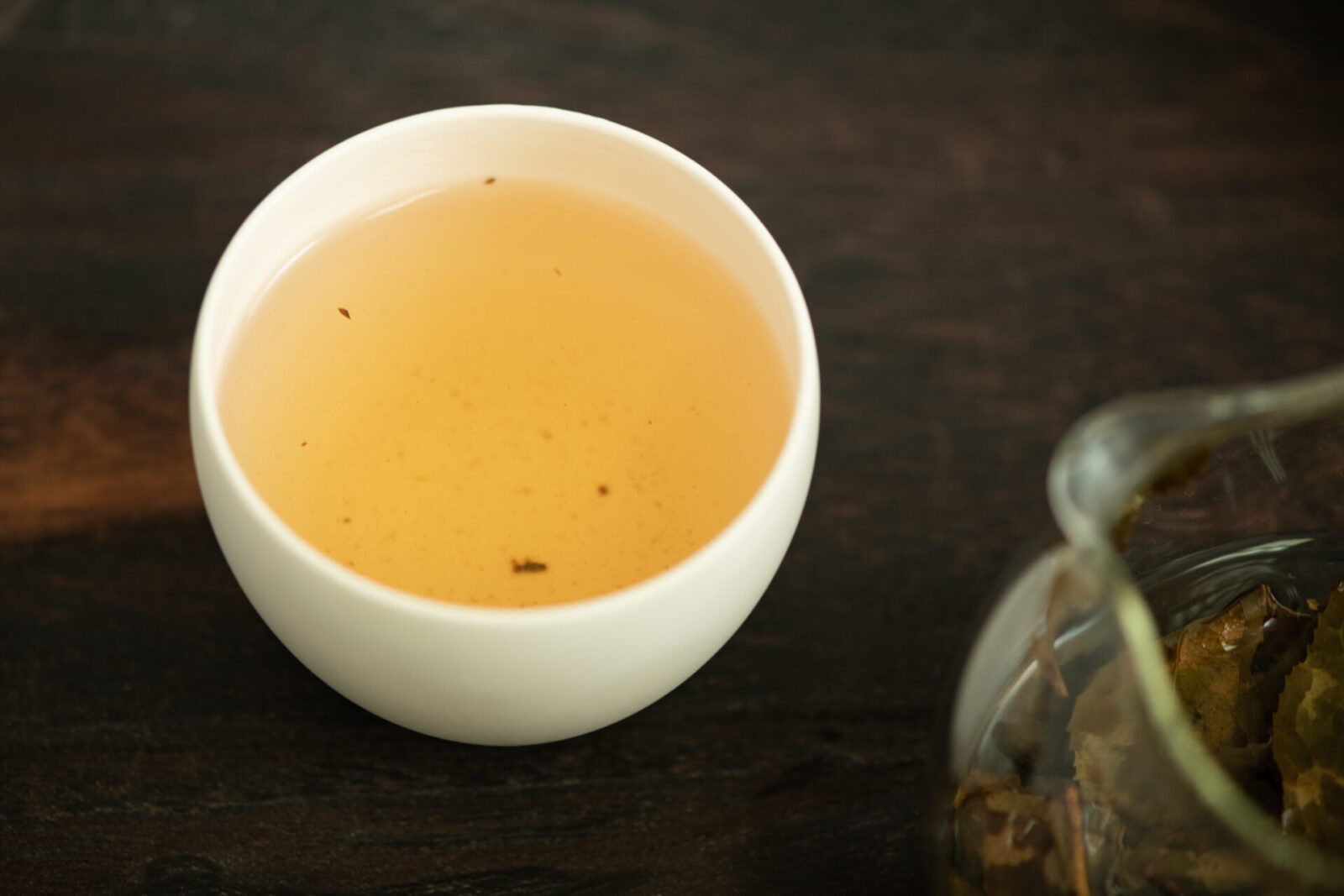
We were surprised to find that once the tea enters your mouth the smell goes away and the tea is quite delicious.
Perhaps it is similar to the experience of eating fermented fish pickled in salt.
Nonetheless, once the tea cools down it’s pungent smell becomes stronger and the flavor deteriorates so we suggest that this tea be enjoyed while it is still warm.
Perhaps mixing it with other spices and using it for cooking is another good way to utilize its unique flavor.
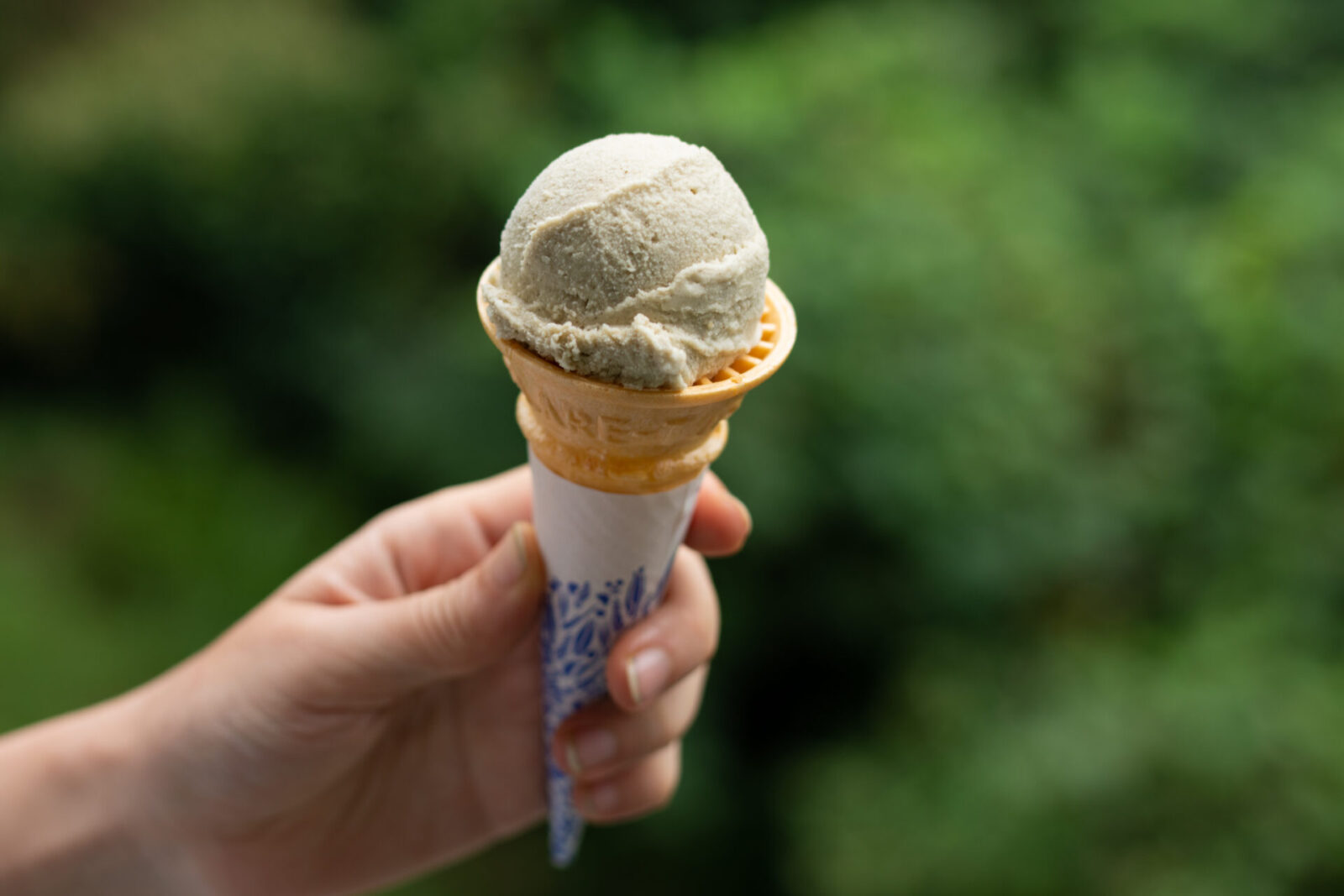
DIG THE TEA Experiments: Journey with Awabancha
While drinking our Awabancha, we looked back and reflected on our experience in its production.
As we have mentioned numerous times, the work surrounding the production of Awabancha was much harder than we had ever imagined. However, it is also true that the experience was a lot more fun and fulfilling than we had expected. Above all, this experience has turned Awabancha into much more than a simple tea for us and we have learned to cherish it.
The more one learns about the production process of tea, sees the landscape in which it is grown, and hears the stories of the farmers who work hard to produce it, the more one can appreciate and enjoy the tea itself.
Awabancha is now a tea we enjoy at all times, whether it be after breakfast, during work breaks or when sharing tea with family. Its unique flavor and aroma has become a part of our daily lives.

I hope that this series on our journey with Awabancha tea has inspired our readers to take interest in it.
If you have never tried it before, we highly recommend that you give it a try.
DIG THE TEA Experiment’s journey with Awabancha is not over yet. It will most definitely continue.
Photo: Yuko Kawashima
Translation: Sophia Swanson
Lives in Tokyo, Japan. Became independent after working as an editor for online media sites “MYLOHAS” and “greenz.jp” and magazine “sotokoto”. Edits and writes for magazines, online media, books, and other media outlets, as well as corporate websites, on themes such as sustainable manufacturing, community development, and working styles. Also acts as director and buyer for the online store and media “ichijitu” which offers everyday products and tools that assist in everyday life.
Editor. Born and raised in Kagoshima, the birthplace of Japanese tea. Worked for Impress, Inc. and Huffington Post Japan and has been involved in the launch and management of media after becoming independent. Does editing, writing, and content planning/production.
